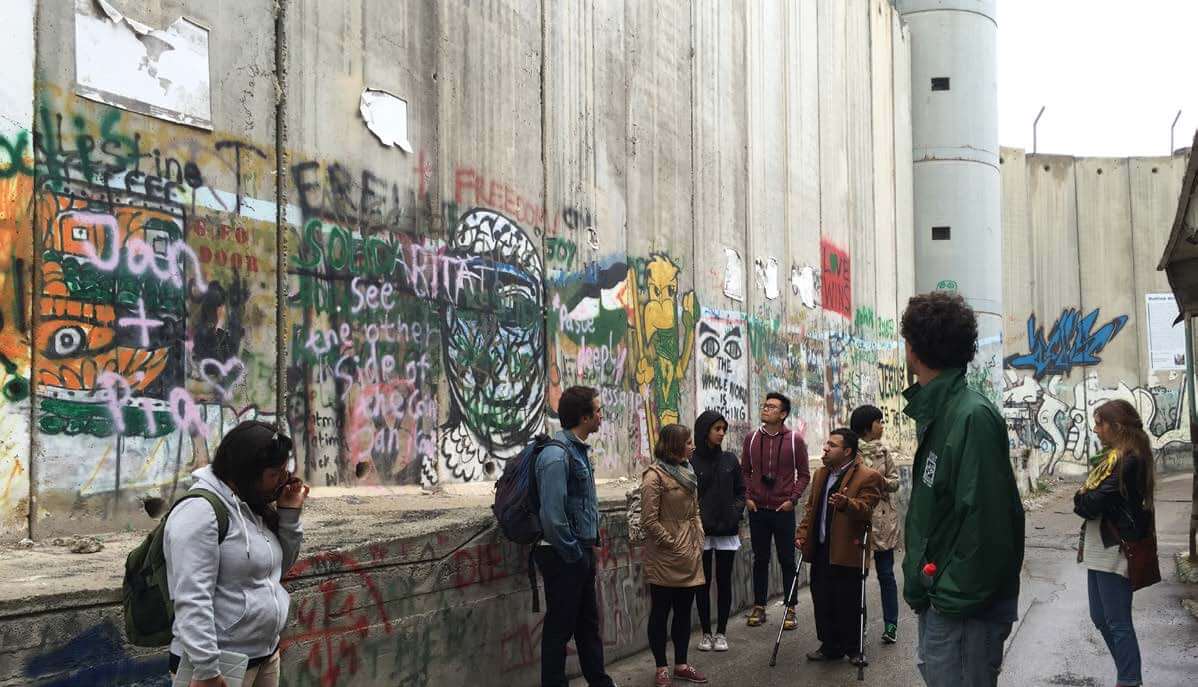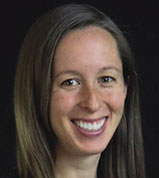Above: Ken Goldman. Jacob’s Ladder Triptych, 2015. Chromaluxe print after performance. Photos by Gideon Cohen
The Security Fence to some, the Apartheid Wall to others—it is this physical barrier that often changes how Jewish travelers to the West Bank see the Israeli-Palestinian conflict. I remember the trepidation that I felt when I first journeyed from the Israeli to the Palestinian side of the wall on a tour to the Occupied Palestinian Territories. I had imagined iron-clad securitization along the wall’s entire route. I had imagined angry Palestinians, desperate for an opportunity to break through the wall and enact revenge on those of us living on the other side. What I witnessed that day dismantled both of these assumptions. I was greeted with kindness by everyone I met and I saw for myself the barrier’s gaps and contradictions.

A tour group stands beside the wall with their Palestinian guide in Bethlehem. Courtesy of the author
Five years later, I began organizing tours for Jewish travelers to the West Bank. Having gone from once ardently defending the State of Israel to now standing in solidarity with Palestinians, I was determined to give others this same opportunity to see the situation differently. My partners and I targeted those who were skeptical of Palestinian narratives. We advertised to study-abroad students, Birthright groups, and other mainstream Zionist programs, hoping to bring some of Israel’s strongest supporters face-to-face with the occupation.
While leading these trips, I also began conducting research for my PhD on these tours’ effects. During an interview with a tour guide named Amy, she tells me:
We used to take them to this specific spot in Bethlehem where there’s a giant gap in the wall … it doesn’t matter if you showed it to them, explained to them how many people climb over it.… They’re going to say no, the wall is keeping us safe.
Her words resonated with me. After years of bringing Jewish travelers to the territories, I had become frustrated with the number of people who remained ideologically unmoved by the experience. I found that even though the people who attended our tours were typically more critical of Israel than their peers, they still clung to many of the core justifications for the occupation. Participants continued to insist on Israel’s exclusive right to violence, they argued for the need to maintain a Jewish demographic majority at all costs, and they blamed the occupation on extremist settlers rather than the Israeli government. Nonetheless, I also saw many travelers experience profound moments of transformation. More than at any other part of the tour, these transformations occurred at the wall.
The wall is unsettling for Jewish travelers to Palestine for many reasons. It challenges the foundational belief among many of Israel’s supporters that the occupation is driven by security. Tourists see the wall’s porousness, its punitive features, and its strategic placement to maximize territorial acquisition. The wall also brings socioeconomic and rights-based disparities between Israelis and Palestinians into stark contrast. Finally, it symbolically and directly draws undeniable parallels between the Palestinian people and other oppressed groups.
… the wall does not simply operate as a divider between Israelis and Palestinians.
A Jewish tourist from the United States named Ileen tells me how she realizes she was wrong before, and she now sees that the wall “has nothing to do with security.” For travelers like Ileen, the wall unravels the idea that the repression of Palestinians is an unavoidable byproduct of necessary security measures. They see how its grey concrete slabs snake against Palestinian neighborhoods to maximize the land and minimize the number of Palestinians on the Israeli side. They see how the wall cuts Palestinians off from their farmlands, families, and livelihoods, as well as how Israelis pass freely through its openings while Palestinians are humiliated at checkpoints. Such imagery sparks criticism of Israel among Jewish travelers, such as Tal, who concludes from his tour, “The wall was an active effort not just to separate the space, but to drive Palestinians away by making their lives miserable.”
Suleiman, a Palestinian guide from Bethlehem, asks his tour group why they consider the Palestinians on this side of the wall to be dangerous while not those who live in Jerusalem. By asking questions like these and by showing how Palestinians can penetrate the wall, tour guides demonstrate how the wall does not simply operate as a divider between Israelis and Palestinians. Instead, the wall perpetuates oppression by usurping resources and providing the infrastructure for surveillance, punishment, and social sorting. Contrary to the argument that the drop in suicide bombings around the time of the wall’s construction can be traced to full separation between Israelis and Palestinians, tour guides show how the wall is a much more complex apparatus designed to dispossess Palestinians of their land, maintain a racialized system of permits and residency, and facilitate continued Israeli settlement of the region.
With the glue of the security justification broken, many tourists now begin to see the inequality between Palestinians and Israelis as a matter of intentional dispossession. Gazing upon the wall from a hilltop in Jerusalem, Madi comments on the contrast of the paved sidewalks and beautiful homes in the Israeli settlement behind us with the burning trash and dilapidated buildings across the barrier. While walls separate, they also create collision. The separation barrier facilitates a juxtapositional proximity between an Israeli world of relative economic prosperity and civil rights, next to Palestinians’ world of occupation and economic strangulation. Yet now, rather than frame such contrasts as unfortunate circumstances, many Jewish travelers see them as injustices.
… what was intended to be a mechanism of blockage and division becomes a pathway to openness and solidarity.
With injustice, there is an oppressor and the oppressed, and the wall forces travelers to name them in Israel/Palestine. In 2012, activists created a mural of Trayvon Martin on the wall. In 2020, they painted the face of George Floyd. These graphics push Jewish tourists to incorporate their newfound awareness of Palestinian dispossession into their broader commitments to social justice. In my interviews with travelers, many even uncomfortably confided in me that they could not help but think about the Nazi ghettos in Europe while standing beneath the wall. Both these implicit and explicit parallels make it difficult to compartmentalize Palestinian suffering, so that Jewish travelers can no longer separate the occupation from their wider moral conscience.
We are told that walls bring security, that they hide realities, and that they disconnect us from each other. For many travelers to Palestine, witnessing the wall reverses these tropes. A supposed beacon of Israeli security, the wall becomes a window into the shakiness of such narratives. Travelers soon realize that Palestinians and Israelis move across and live on both sides of the wall, and that full separation does not actually exist. As the wall reveals these flows, it simultaneously situates Israeli privilege directly next to Palestinian oppression. Contrasts that were once hidden now come directly into view. Finally, in protest of the divisions and disconnection that the wall attempts, activists repurpose it to communicate messages of solidarity, linking the Palestinian struggle to current and historical incidents of persecution. Though it was designed to be a mechanism of control, theft, and subjugation, Palestinian tour guides are managing to turn the wall’s infrastructure against itself. Through this activism, what was intended to be a mechanism of blockage and division becomes a pathway to openness and solidarity.

Emily Schneider is assistant professor in the department of criminology and criminal justice at Northern Arizona University. Dr. Schneider’s research has been published in peer-reviewed journals, such as Sociological Focus and the International Journal of Tourism Cities, and it has received funding from a variety of sources including the National Science Foundation and the National Institutes of Health. She is currently working on a book manuscript that examines American Jews’ changing relationship to Israel/Palestine through the framework of alternative tourism to the West Bank.